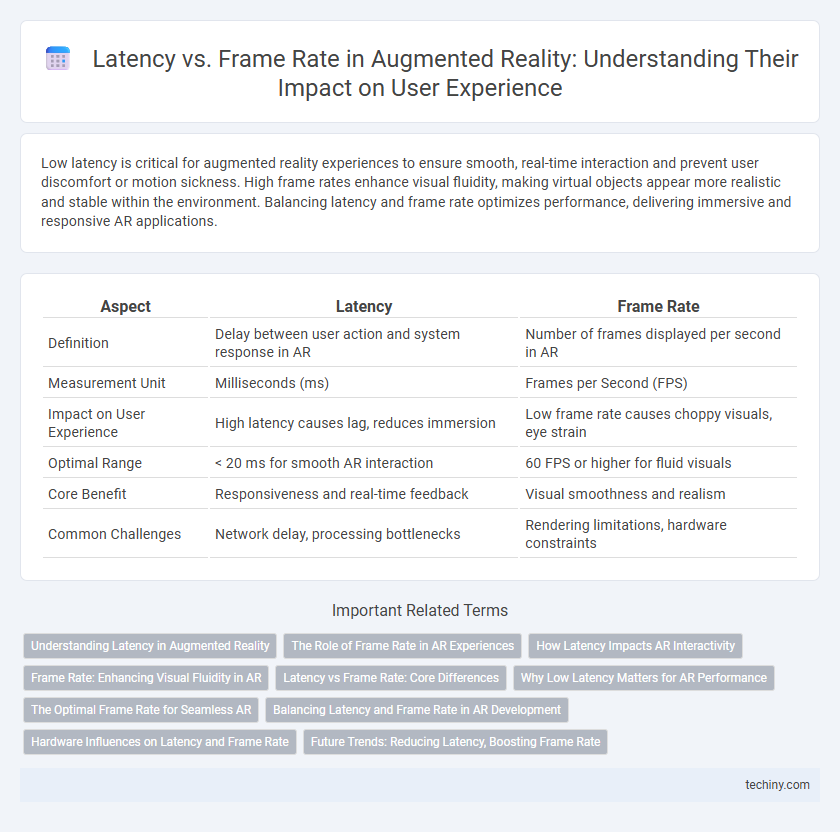Low latency is critical for augmented reality experiences to ensure smooth, real-time interaction and prevent user discomfort or motion sickness. High frame rates enhance visual fluidity, making virtual objects appear more realistic and stable within the environment. Balancing latency and frame rate optimizes performance, delivering immersive and responsive AR applications.
Table of Comparison
| Aspect | Latency | Frame Rate |
|---|---|---|
| Definition | Delay between user action and system response in AR | Number of frames displayed per second in AR |
| Measurement Unit | Milliseconds (ms) | Frames per Second (FPS) |
| Impact on User Experience | High latency causes lag, reduces immersion | Low frame rate causes choppy visuals, eye strain |
| Optimal Range | < 20 ms for smooth AR interaction | 60 FPS or higher for fluid visuals |
| Core Benefit | Responsiveness and real-time feedback | Visual smoothness and realism |
| Common Challenges | Network delay, processing bottlenecks | Rendering limitations, hardware constraints |
Understanding Latency in Augmented Reality
Latency in augmented reality critically impacts user experience by causing perceptible delays between real-world movements and digital overlay responses. Low latency, typically under 20 milliseconds, ensures smooth interaction and reduces motion sickness, maintaining immersion. Frame rate stability above 60 frames per second complements low latency by providing fluid visuals, but latency remains the primary factor affecting system responsiveness.
The Role of Frame Rate in AR Experiences
Higher frame rates in augmented reality (AR) significantly enhance the smoothness and realism of virtual overlays, reducing motion blur and improving user immersion. Maintaining a consistent frame rate of at least 60 frames per second (fps) is critical to minimize latency perception and prevent motion sickness during interactive AR applications. Optimized frame rates directly contribute to seamless alignment of digital content with the real world, ensuring accurate tracking and responsive user experiences.
How Latency Impacts AR Interactivity
Latency in augmented reality significantly affects interactivity by causing delays between user actions and system responses, leading to a disjointed experience. High latency disrupts real-time interaction, resulting in motion sickness and reduced user immersion. Optimizing low latency is essential for seamless tracking, accurate environment mapping, and maintaining natural, responsive AR experiences.
Frame Rate: Enhancing Visual Fluidity in AR
High frame rates in augmented reality are crucial for maintaining visual fluidity, reducing motion blur, and preventing user discomfort or motion sickness. Achieving a frame rate of 60 FPS or higher enhances the immersive experience by delivering smooth transitions between virtual and real-world elements. Optimizing frame rate performance requires balancing computational load with hardware capabilities to ensure consistent and responsive AR interactions.
Latency vs Frame Rate: Core Differences
Latency and frame rate are critical metrics in augmented reality, with latency referring to the delay between user action and system response, while frame rate measures the number of frames displayed per second. Low latency is essential for seamless interaction and minimizing motion sickness, whereas a high frame rate ensures smooth visual transitions and realistic rendering. Optimizing both factors enhances user immersion by balancing responsiveness with visual fluidity in AR experiences.
Why Low Latency Matters for AR Performance
Low latency is crucial for augmented reality performance because it ensures real-time responsiveness, reducing motion sickness and enhancing user immersion. High frame rates combined with minimal latency allow AR devices to accurately align virtual objects with the physical environment, maintaining spatial consistency. Optimizing latency improves the synchronization between user movements and visual feedback, which is essential for seamless AR experiences.
The Optimal Frame Rate for Seamless AR
Maintaining an optimal frame rate of 60 frames per second significantly reduces latency in augmented reality applications, ensuring smooth and realistic user experiences. Lower frame rates increase motion blur and lag, disrupting the seamless interaction necessary for effective AR immersion. Achieving this balance enhances real-time responsiveness while minimizing visual fatigue and motion sickness.
Balancing Latency and Frame Rate in AR Development
Balancing latency and frame rate in augmented reality development is crucial for delivering seamless user experiences, as excessive latency can cause motion sickness and disrupt immersion while low frame rates result in choppy visuals. Optimizing sensor data processing and rendering pipelines minimizes latency, often targetting less than 20 milliseconds, while maintaining frame rates at or above 60 frames per second ensures smooth animation and responsiveness. Developers leverage techniques such as asynchronous reprojection and predictive tracking to harmonize these parameters, enhancing AR application performance and user comfort.
Hardware Influences on Latency and Frame Rate
Hardware components such as GPUs, processors, and display refresh rates significantly influence latency and frame rate in augmented reality systems. High-performance GPUs and CPUs reduce rendering times, lowering latency and enabling smoother frame rates essential for real-time interaction. Display technology with higher refresh rates minimizes motion blur and input lag, directly enhancing the AR experience by synchronizing visuals with user movements.
Future Trends: Reducing Latency, Boosting Frame Rate
Emerging technologies in augmented reality prioritize reducing latency to under 10 milliseconds, enhancing real-time responsiveness critical for immersive user experiences. Innovations in GPU acceleration and AI-driven frame interpolation are expected to boost frame rates beyond 120 frames per second, ensuring smoother visuals without motion sickness. Future trends focus on integrated hardware-software optimizations to synchronize latency reduction with ultra-high frame rate rendering, driving next-generation AR applications.
Latency vs Frame Rate Infographic

 techiny.com
techiny.com